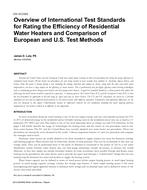Description
Recently the United States and the European Union have made major revisions to their test procedures for rating the energy efficiency of residential water heaters. Water heater test procedures are also being revised or have recently been adopted in Australia, Japan, Korea, and China. How hot water is drawn during a test, including the timing, duration and volume of draws, along with the inlet and outlet water temperatures, can have a large impact on the efficiency of water heaters. This is particularly true for higher efficiency water heating technologies such as condensing gas-fired storage water heaters and heat pump water heaters. A good test standard should use a draw pattern that reflects the field usage the water heater would be expected to experience. A common goal of the United States (US) and the European Union (EU) is that the test procedures be applicable to the full range of types and sizes of water heaters. The US and EU procedures are based on a 24-hour simulated use test and use different draw patterns to rate water heaters with different capacities. Similarities, and important differences, of the tests are discussed in this paper. Unfortunately, because of differences between the test standards, including hot water tapping patterns, comparison of test results is likely to be difficult, if not impossible.
Citation: ASHRAE Papers: 2015 ASHRAE Annual Conference, Chicago, IL
Product Details
- Published:
- 2015
- Number of Pages:
- 7
- File Size:
- 1 file , 2.1 MB
- Product Code(s):
- D-CH-15-C043




